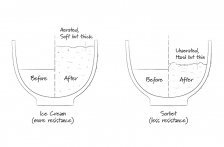This ice cream maker senses the resistance to stop at the right time for whatever you’re making but make sure you select the setting carefully, as it can make a big difference in the end result.
The creamier they are, the richer they churn.
Many frozen treats have varying levels of dairy and fat, from none of either in the case of sorbet, to lots of both in the case of some ice creams. Apart from impacting taste, dairy and fat levels affect resistance when they’re being churned.
So if you go from making ice cream to say a sorbet, you need to stop churning at a different point in the process to get the right result.
The main reason for this is most dairy (at the right temperature) can be manipulated to retain air. From frothed milk to whipped cream, even whisked egg yolks, under the right conditions dairy will suspend air bubbles within,
causing it to increase in size. Ice cream, for example, can double its initial volume in going from a liquid to a solid, mainly due to the air retained whilst churning.
Furthermore, the fact that fat is more viscous than water means ice cream creates more resistance while churning than thinner, less aerated mixes like sorbet.

